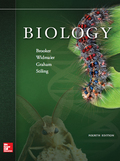
Concept explainers
Introduction: A mutation is a sudden change in the genome of an organism. The change obtained can be hereditary or can be influenced by means of a mutagen. The period of mutagen exposure determines the degree by which an organism is affected.
Answer to Problem 1TY
Correct answer: A mutation in which there is a removal of single base pair within the coding sequence of a gene and the inactivation of the protein encoded by the gene is called “a frameshift mutation”. Hence, the correct answer is option d.
Explanation of Solution
Reason for correct answer:
The addition and deletion of a single base pair in DNA results in frameshift mutations. In this type of mutation, there is a shifting of the reading frame at the site of mutation which results in the formation of non-functional genes.
Option d. is given as “a frameshift mutation.”
A type of mutation in which there is a deletion of single base pair in the coding sequence of a gene and the inactivation of the protein encoded by the genes is called “a frameshift mutation”. Hence, the correct answer is option d.
Reason for incorrect answer:
Option a. is given as “a silent mutation.”
A silent mutation is a type of point mutation and it does not affect the gene product. Hence, option a. is incorrect.
Option b. is given as “a missense mutation.”
The missense mutations take place by means of base substitutions. Hence, option b. is incorrect.
Option c. is given as, “a nonsense mutation.”
When the process of translation terminates by means of stop codon, the formed protein can be short and nonfunctional. Such mutation is called as nonsense mutation. Hence, option c. is incorrect.
Option e. is given as “both b and c.”
Both missense mutation and nonsense mutation cannot be expressed by the means addition or deletion of
Hence, the options a., b., c. and e. are incorrect.
A “frameshift mutation” is a mutation in which there is a removal of a single base pair within the coding sequence and the inactivation of the protein encoded by the gene.
Want to see more full solutions like this?
Chapter 14 Solutions
EBK BIOLOGY
- Molecular Biology Explain/discuss how “slow stop” and “quick/fast stop” mutants wereused to identify different protein involved in DNA replication in E. coli.arrow_forwardMolecular Biology Question A gene that codes for a protein was removed from a eukaryotic cell and inserted into a prokaryotic cell. Although the gene was successfully transcribed and translated, it produced a different protein than it produced in the eukaryotic cell. What is the most likely explanation?arrow_forwardMolecular Biology LIST three characteristics of origins of replicationarrow_forward
- Molecular Biology Question Please help. Thank you For E coli DNA polymerase III, give the structure and function of the b-clamp sub-complex. Describe how the structure of this sub-complex is important for it’s function.arrow_forwardMolecular Biology LIST three characteristics of DNA Polymerasesarrow_forwardMolecular Biology RNA polymerase core enzyme structure contains what subunits? To form holo enzyme, sigma factor is added to core. What is the name of the structure formed? Give the detailed structure of sigma factor and the function of eachdomain. Please help. Thank youarrow_forward
- Molecular Biology You have a single bacterial cell whose DNA is labelled with radioactiveC14. After 5 rounds of cell division, how may cells will contain radioactive DNA? Please help. Thank youarrow_forward1. Explain the structure and properties of atoms and chemical bonds (especially how they relate to DNA and proteins). Also add some pictures.arrow_forward1. In the Sentinel Cell DNA integrity is preserved through nanoscopic helicase-coordinated repair, while lipids in the membrane are fortified to resist environmental mutagens. also provide pictures for this question.arrow_forward
- Explain the structure and properties of atoms and chemical bonds (especially how they relate to DNA and proteins). Also add some pictures.arrow_forwardIn the Sentinel Cell DNA integrity is preserved through nanoscopic helicase-coordinated repair, while lipids in the membrane are fortified to resist environmental mutagens. also provide pictures for this question.arrow_forward1. Explain how genetic information is stored, copied, transferred, and expressed. Also add some pictures for this question.arrow_forward
 Human Heredity: Principles and Issues (MindTap Co...BiologyISBN:9781305251052Author:Michael CummingsPublisher:Cengage Learning
Human Heredity: Principles and Issues (MindTap Co...BiologyISBN:9781305251052Author:Michael CummingsPublisher:Cengage Learning Human Biology (MindTap Course List)BiologyISBN:9781305112100Author:Cecie Starr, Beverly McMillanPublisher:Cengage Learning
Human Biology (MindTap Course List)BiologyISBN:9781305112100Author:Cecie Starr, Beverly McMillanPublisher:Cengage Learning Concepts of BiologyBiologyISBN:9781938168116Author:Samantha Fowler, Rebecca Roush, James WisePublisher:OpenStax College
Concepts of BiologyBiologyISBN:9781938168116Author:Samantha Fowler, Rebecca Roush, James WisePublisher:OpenStax College Biology (MindTap Course List)BiologyISBN:9781337392938Author:Eldra Solomon, Charles Martin, Diana W. Martin, Linda R. BergPublisher:Cengage Learning
Biology (MindTap Course List)BiologyISBN:9781337392938Author:Eldra Solomon, Charles Martin, Diana W. Martin, Linda R. BergPublisher:Cengage Learning Biology 2eBiologyISBN:9781947172517Author:Matthew Douglas, Jung Choi, Mary Ann ClarkPublisher:OpenStax
Biology 2eBiologyISBN:9781947172517Author:Matthew Douglas, Jung Choi, Mary Ann ClarkPublisher:OpenStax





